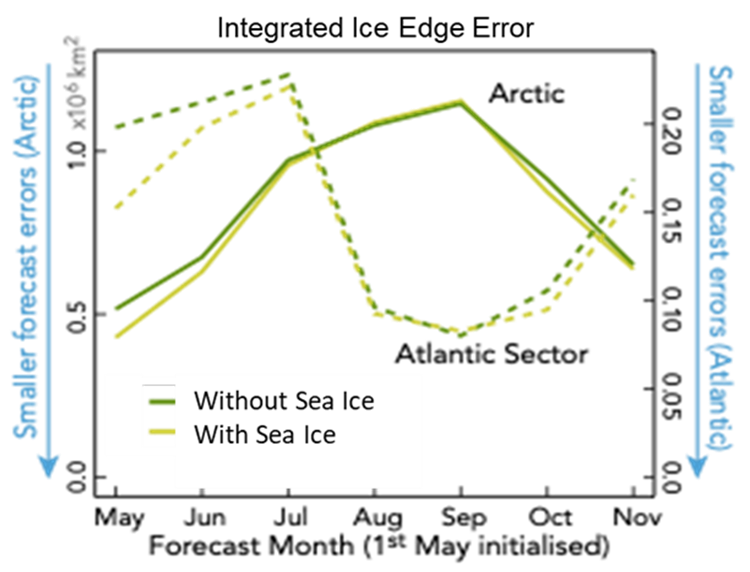Assimilating ESA CCI Sea Ice Observations to Improve Summer Predictions in the Arctic and Beyond
Key results
Using ESA CCI Sea Ice Concentration data improves seasonal climate predictions
- Assimilating ESA CCI Sea Ice Concentration data improves the forecast of sea ice extent and sea surface temperature in both the Arctic and Atlantic.
- This leads to better prediction of large-scale atmospheric circulation and hence improvements in the prediction of surface temperature and precipitation in Eurasia.
Motivation
The Arctic is a key region of change where ongoing and projected sea ice loss has been linked to enhanced warming due to the presence of important feedback mechanisms.
A growing number of studies suggests that these major long-term changes in the Arctic can also impact the climate of the mid-latitudes via teleconnection mechanisms (Blackport & Screen, 2021; Chripko et al., 2021; Wu et al., 2021). However, it is less clear if shorter-term changes in Arctic sea ice can also influence the climate of other remote regions, and if this influence can be leveraged for prediction purposes.
This work compares a forecast with and without assimilation of ESA CCI Sea Ice Concentration (SIC) data to assess the role of sea ice in seasonal prediction skill.
Experiment
A 30-member ensemble of seasonal forecasts for the period 1992-2018 using the EC-Earth model is generated for the experiment including assimilation of ESA CCI SIC and compared to a control set of forecasts for the same period without but without sea-ice data being assimilated.
For both experiment and control, the model is initialised from an ocean-sea ice reconstruction assimilating, through nudging techniques, the ocean temperature and salinity of the ocean reanalysis (ORAS5).
Results
Assimilating sea ice concentrations (SIC) reduces forecast errors in Arctic sea ice extent, particularly from May to July (Figure 1). These improvements are most noticeable in the Atlantic sector with increased skill in forecasting sea surface temperature (SST). This improvement is explained through a more realistic teleconnection mechanism with ice in the Labrador Sea. Improved SSTs persist over summer leading to better prediction of the large-scale atmospheric circulation. The better circulation forecast then leads to improvements in the prediction of surface temperature and precipitation in Eurasia.

References
Acosta Navarro J., V. Lapin, P. Ortega, J. García-Serrano (2022) “Added value of Arctic sea ice concentration assimilation for seasonal climate forecasts” (Submitted to Environmental Research Letters)
Blackport, R. & Screen, J. A. (2021) Observed Statistical Connections Overestimate the Causal Effects of Arctic Sea Ice Changes on Midlatitude Winter Climate. J. Clim. 34 (8), DOI: https://doi.org/10.1175/JCLI-D-20-0293.1
Chripko, S., Msadek, R., Sanchez-Gomez, E., Terray, L., Bessières, L., & Moine, M. (2021). Impact of Reduced Arctic Sea Ice on Northern Hemisphere Climate and Weather in Autumn and Winter, Journal of Climate, 34(14), 5847-5867. Retrieved Jul 23, 2021, from https://journals.ametsoc.org/view/journals/clim/34/14/JCLI-D-20-0515.1.xml
Wu, H., Zhang, R., Wang, Y., Hong, M., Yan, H., Zhu, J. (2021) Analyzing the effects of sea ice melting and atmospheric heat transport on the warming around arctic based on comparable analysis and coupling modes, Atmospheric Research, Volume 258, 105630, ISSN 0169-8095, https://doi.org/10.1016/j.atmosres.2021.105630
About the author

This article was produced in 2022 by Pablo Ortega. Pablo co-leads the climate prediction activities at the BSC since 2017. He is interested in the sources of internal climate predictability from seasonal to decadal time scales, with a particular interest on the role of the ocean and the cryosphere. In CMUG, he has worked on the exploitation of CCI products for forecast verification, and for improving forecast initialisation.

